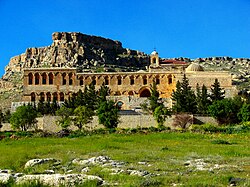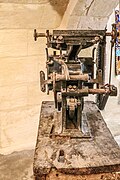 | |
  | |
| Monastery information | |
|---|---|
| Other names | Dayro d-Mor Hananyo |
| Denomination | Syriac Orthodox |
| Established | 493 |
| Dedicated to | Mor Hananyo |
| Controlled churches | Church of the Mother of God, Beth Kadishe |
| People | |
| Founder(s) | Mor Shelmon |
| Site | |
| Location | Near Mardin, Turkey |
| Coordinates | 37°17′58″N 40°47′33″E / 37.29944°N 40.79250°E / 37.29944; 40.79250 |
Mor Hananyo Monastery or Monastery of Saint Ananias (Turkish: Deyrulzafaran Manastırı; Syriac: ܕܝܪܐ ܕܡܪܝ ܚܢܢܝܐ) is an important Syriac Orthodox monastery located three kilometers south east of Mardin, Turkey, in the Syriac cultural region known as Tur Abdin. Mor Hananyo Monastery was the headquarters of the Syriac Orthodox Church from c. 1160 until 1932.
It is usually better known by its nickname, the Saffron Monastery (Syriac: ܕܝܪܐ ܕܟܘܪܟܡܐ, Dairo d-Kurkmo; Arabic: دير الزعفران, Dairu 'l-Za‘farān) which is derived from the warm color of its stone. Syriac Orthodox culture was centered in two monasteries near Mardin (west of Tur Abdin), Mor Gabriel and Deyrulzafaran.
History
The Mor Hananyo Monastery is built on the site of a 4500-year-old temple dedicated to the Mesopotamian sun god Shamash, which was then converted into a citadel by the Romans. After the Romans withdrew from the fortress, Mor Shlemon transformed it into a monastery in 493 AD. In 793 the monastery was renovated after a period of decline by the Bishop of Mardin and Kfartuta, Mor Hananyo, who gave the monastery its current name.
The monastery was later abandoned and re-founded by the bishop of Mardin, John, who carried out important renovations and moved the see of the Syriac Orthodox Church here before his death on the 12th of July 1165. Therefore, From 1160 until 1932 it was the official seat of the patriarch of the Syriac Orthodox Church, after which it was moved first to Homs and in 1959 to Damascus. However, The Patriarchal throne and many relics are still located in the Monastery, as well as the Tombs of various Patriarchs.

In 451, the Miaphysite congregation of the Syrian Orthodox Church (Jacobites) split from the Byzantine Church after the Council of Chalcedon's debate about the true nature of Christ. It served as the seat of the Syrian Orthodox church from 493 to the 1920s. The hardy Mardin Christian community has dwindled from 2000 to 200 over the past 30 years. The church still uses Aramaic, Jesus’ language, as its liturgical tongue. Services are held daily, led by one of the two remaining monks. To the right of the entrance, down a few steps is a prayer room originally used as a temple to Shamash in 2000 B.C. Above it is an old mausoleum formerly used as a medical school; the wooden doors are inlaid with lions and serpents. The main chapel still retains patches of its original turquoise coat and houses a 300-year-old Bible, a 1000-year-old baptismal font, and a 1600-year-old mosaic floor.
Temple of the Sun in the basement

True to its original purpose of a temple dedicated to the Mesopotamian sun god Shamash, the monastery has 365 rooms in total, each symbolizing a day the Earth spends on its full cycle around the Sun. The remains of that temple may be found in a basement of the monastery, but as the structure has not been scientifically researched, this identification has to be taken with a grain of salt. That underground space is, nonetheless, the oldest part of the monastery. It consists of two rooms: the smaller one is covered with stone vaults, while the bigger one has a ceiling made of blocks of stone bound without mortar. The first rays of the sun enter the temple through a small hole in its eastern wall every morning.
Printing press

The monastery has made a great effort to print books. A printing press was bought during a journey to England in 1874 and subsequently shipped to Antonius Azar in Aleppo. In 1881 the press was moved to the Monastery and in 1882 a separate house for the press was built. In the 1880s the archbishop of Jerusalem was sent to England to learn the printing. He came back with a second press as a backup for the first, which was located in Jerusalem. In 1888 the first book was printed in the monastery and a copy was sent to Queen Victoria. In the Monastery books kept being printed until 1917. From 1913 to 1914 also a periodical named Hikmet was printed. In the Turkish Republic the printing press was used to print official documents as it was the only press in the region.
In the printing house, books in Arabic, Turkish, and Syriac, were published until 1969, and a monthly magazine called Öz Hikmet until 1953. Some of the pieces are exhibited in the monastery, others in the Kırklar Church in Mardin.
-
The Saffron Monastery
-
 The Saffron Monastery
The Saffron Monastery
-
The tree lined path to the monastery
-
The main entrance, taken from the outer courtyard
-
The inner courtyard
-
The Patriarchal throne
-
 Close-up picture of a column inside the monastery
Close-up picture of a column inside the monastery
-
 Mor Hananyo Monastery, or The Saffron Monastery in English
Mor Hananyo Monastery, or The Saffron Monastery in English
-
 Bible and Pulpit
Bible and Pulpit
-
 Outside View
Outside View
See also
References
- Markessini, J. (2012). Around the World of Orthodox Christianity – Five Hundred Million Strong: The Unifying Aesthetic Beauty. Dorrance Publishing Company. p. 31. ISBN 978-1-4349-1486-6. Retrieved 25 October 2019.
- ^ Yuhanon, B. Beth. "The Methods of Killing in the Assyrian Genocide". Sayfo 1915. p. 180.
- Üngör 2011, p. 15.
- "Eglise syriaque orthodoxe d'Antioche". Archived from the original on 2012-02-26. Retrieved 2014-03-05.
- "Mor Hananyo Dayro, Turkey". Archived from the original on 2007-09-27.
- Traces in the Desert: Journeys of Discovery across Central Asia. (2008). Christoph Baumer. I. B. Tauris, New York, p. 21.
- "Mardin". Archived from the original on 2021-08-26. Retrieved 2017-04-08.
- Syriac Churches & Monasteries in Mardin & Midyat Retrieved 2023-10-05.
- Langer, Robert; Taşğın, Ahmet (2014). "The Establishment of the Syrian Orthodox Patriarchate Press". Geoffrey Roper (Ed.): Historical Aspects of Printing and Publishing in Languages of the Middle East (Islamic Manuscripts and Books, 4), 181–192: 181.
- Printing tradition in Mor Hananyo monastery Retrieved 2023-10-05.
Sources
- Üngör, Uğur Ümit (2011). The Making of Modern Turkey: Nation and State in Eastern Anatolia, 1913–1950. Oxford University Press. ISBN 978-0-19-965522-9.
External links
- Official website
- Charity House
- Presentation Archived 2012-02-06 at the Wayback Machine
- Presentation
| Syriac Orthodox monasteries | |
|---|---|
| India | |
| Iraq | |
| Jerusalem | |
| Syria | |
| Turkey | |